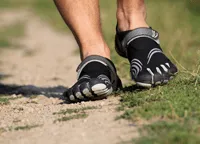Barefoot running has been embraced by many, and at this point it’s much more than just a passing fad. After all, humans were not born with shoes on their feet and it’s only been 40 years or so since athletic shoes became popular. This trend is likely here to stay, but barefoot running doesn’t necessarily mean running sans shoes.
By now you’ve probably seen at least one runner donning those funny looking shoes. These shoes give the feeling of freedom you get from going barefoot while still providing some protection from the elements and sharp objects. A word of caution, barefoot running doesn’t mean carelessly tossing off your shoes and running barefoot on the pavement; both serious athletes and casual runners need to take steps to avoid injury.
Why should you consider trying it?
There are currently no scientific studies that have proven barefoot running reduces injuries or that traditional running shoes directly cause injury. However, it’s barefoot runners themselves who are convinced that “running free” is best and it’s only a matter of time before the scientific community catches up.

Some of the biggest skeptics have converted to running barefoot – including the co-author of an academic paper published in 2010, Irene Davis, physical therapy professor at the University of Delaware. The paper showed evidence that our popular modern, cushiony running shoes may change the body’s natural gait eventually leading to injuries like plantar fasciitis and tibial stress fractures
Barefoot runners often develop a more natural gait and strengthen the muscles, tendons and ligaments of the foot while learning to land on their forefoot rather than on their heel. Runners inadvertently developed the heel strike due to the excessive padding found on running shoes. More efficient runners have a midfoot landing that allows their strides to be smooth, light and flowing as well as allowing the arches to act as a natural shock absorber.
Barefoot running can also help improve balance and make you feel more grounded and connected to your environment. While barefoot running may not be for everyone, many have found that they’ve experienced far fewer injuries without wearing traditional athletic shoes in addition to the sense of freedom.
If you’d like to try it, remember that with anything new your body may have to adjust – especially those who are used to wearing cushioned shoes all the time.
Keep these tips in mind for success:
• Start out slowly, gradually increasing distance. You might try running barefoot for a mile with the remainder of your typical run wearing your regular shoes.
• Barefoot running gives your calf muslces a major workout – by performing calf muscle strengthening exercises for a few weeks or more before beginning, you’ll be ahead of the game.
• Start by running on a soft surface, like the sand or grass while paying close attention to your body’s signals and stop if you experience any pain.
• When trying any new exercise be sure to get plenty of rest, stay hydrated and eat a healthy, balanced diet.
-The Alternative Daily
